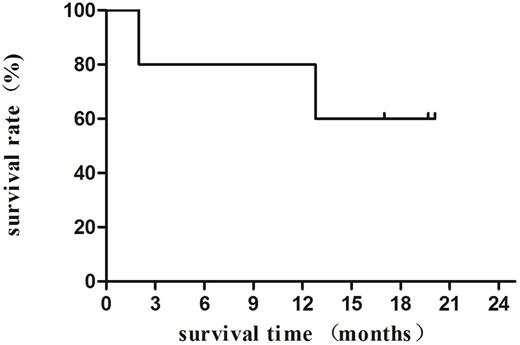Abstract
Background:
Adult T-cell leukemia (ATL) caused by human T-cell lymphotropic virus type I (HTLV-1) infection is an aggressive malignancy. There is no effective and standard treatment for it so far and most patients died within 1 year after diagnosis. Moreover, a high prevalence of HTLV-1 infection has been identified in our region by our previous work.
OBJECTIVE:
To improve the prognosis of ATL, we performed intensive chemotherapy including DA-EDOCH regimen, particularly followed by allogeneic hematopoietic stem cell transplantation (allo-HSCT) and evaluate the efficacy and safety profile.
METHODS:
A total of 12 consecutive ATL patients treated at our center from Mar. 2013 to Jul. 2015 are retrospectively analyzed. The diagnoses were confirmed by the detection of HTLV-I provirus genes by PCR, which has been established in our institute. The median age of the patients is 50.8 (range 28-66) years. 10 patients received intensive chemotherapy as the induction therapy while 2 quit at the time of diagnosis. 5 patients were administrated with DA-EDOCH regimen while 5 with other regimens than DA-EDOCH. DA-EDOCH regimen is a variation of dose-adjusted EPOCH regimen with the replacement of prednisone (60 mg/m2 per day) by dexamethasone (15 mg/m2 per day). After the intensive chemotherapy, 2 out of 5 patients with DA-EDOCH regimen were in complete remission (CR) and then transplanted from haplo-identical related donors. Before the conventional regimens Bucy followed by prophylaxis donor lymphocyte infusion, both received a course of salvage chemotherapy including fludarabine and cytarabine for 5 days registered on http:// ClinicalTrials.gov (NCT02328950). The GVHD prophylaxis consisted of ATG, CsA and MTX.
RESULTS:
All 5 patients who didn't receive DA-EDOCH regimen died of disease progress, while among 5 patients with DA-EDOCH regimen, 2 achieved CR, 2 PR and 1 died. With a median follow-up of 16.6 (2-20.1) months, 3 patients respond to DA-EDOCH are still alive. 2 patients in CR achieved successful engraftment with complete donor chimerism in one month post haplo-identical transplant. Both were received prophylaxis donor lymphocyte infusion and the immunosuppressive agents were abruptly discontinued for induction of a graft-verus-ATL (GVL) effect. They keep remain alive and disease free longer than 1.5 years so far without severe graft-versus-host (GVHD), and the most striking is that HTLV-1 proviral DNA became undetectable after allo-HSCT. None of these patients had severe infection or organ failure during the treatment.
CONCLUSION:
It revealed a significant survival benefit from DA-EDOCH regimen. When followed by allo-HSCT, it shows great promise to the long-term cure of ATL with the GVL effect. Haplo-identical transplantation can be an alternative option for the ATL patients without increasing non-relapse mortality.
The Kaplan-Meier curve of overall survival for 5 patients with DA-EDOCH regimen.
With a median follow-up of 16.6 (2-20.1) months, 3 out of 5 patients respond to DA-EDOCH are still alive.
The Kaplan-Meier curve of overall survival for 5 patients with DA-EDOCH regimen.
With a median follow-up of 16.6 (2-20.1) months, 3 out of 5 patients respond to DA-EDOCH are still alive.
No relevant conflicts of interest to declare.
Author notes
Asterisk with author names denotes non-ASH members.


This feature is available to Subscribers Only
Sign In or Create an Account Close Modal